One-shooters don’t have obvious advantages over repeaters, but there are some.
In this age of sub-MOA autoloading AR rifles, why would anyone bother with a single shot?
Single shots are not for firepower, efficiency or enhanced productivity. Single shots are for joy. For romance. Challenge. Sometimes, beauty and elegance. A single shot is to rifles what a fly rod is to a trotline.
Single shots often look good, feel good and, if properly built, handle beautifully. And the man or woman who hunts with one is confident and likely competent. Extremely competent.
“You tend to make that first shot count,” says Glenn Soroka, the New Zealander who makes the rare, expensive and gorgeous Soroka falling-block, single-shot rifle. It’s a familiar sentiment. Many a hunter began with a single shot and an admonition from Dad: “You get one shot. Make it count.”
This limitation taught the novice the value in stalking close, waiting patiently and holding fire until conditions are perfect. That’s a great way to approach any hunt.
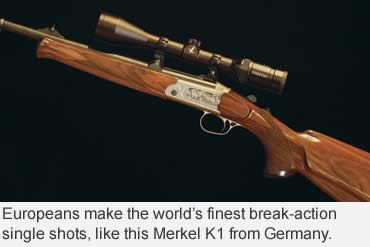 Singularly Different Single Shots
Singularly Different Single Shots
Not all single shots function the same. Like repeaters, single shots operate via lever, bolt or by breaking at the breech. Some are opened by pulling back a rolling breech block (Remington Rolling Block) or lifting a “lid” (trapdoor Springfield). And, of course, the original single shot was and still is loaded from the muzzle.
We all know how muzzleloaders work. Here’s a look at the other single-shot types.
Rolling Block: Remington delivered the first 5,000 of these “split breech” guns in 1868. Designed during the Civil War, the Rolling Block’s breech block rolls back when you pull it, much like an external hammer.
A rolling block much like the original is available from Remington’s Custom Shop. Uberti also makes rolling block replicas in .45-70, .38-55, .30-30, .22 LR, .22 Mag and .17 HMR.
Trapdoor Springfield: The military cartridge rifle of 1873 used by Custer at the Little Bighorn, this gun retains the large external hammer of previous caplocks. The breech block, hinged atop the breech, swings up to expose the chamber. A .45-70 cartridge is pushed into the breech, and the lid is closed and locked with a toggle.
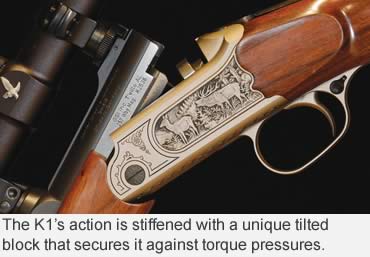 Bolt Actions: Any bolt-action repeater can be made a single shot by neglecting to include the magazine and its attendant mechanical operating parts. The added rigidity of the solid bottom makes this style potentially more accurate, so you see it most often on target and varmint rifles. Many manufacturers of modern bolt-action repeaters will offer target or varmint versions as single shots.
Bolt Actions: Any bolt-action repeater can be made a single shot by neglecting to include the magazine and its attendant mechanical operating parts. The added rigidity of the solid bottom makes this style potentially more accurate, so you see it most often on target and varmint rifles. Many manufacturers of modern bolt-action repeaters will offer target or varmint versions as single shots.
Break Actions: Think of double-barrel shotguns. Swing a lever or push a button to release the catch, and the barrel swings down from the standing breech on a large hinge pin, exposing the chamber. You drop a cartridge in, swing the barrel up and the breech snaps shut. This action is found in the T/C Contender and Encore, H&R Handi-Rifle, Rossi Wizard and many others. Simple, strong and durable, break actions are chambered for everything from .22 Long Rifle to centerfire magnums.
Falling Blocks: Also known as drop blocks. The first commercially successful falling block was the Sharps design of 1848. It was accepted by our military as the 1863 in .50-70, but was changed to .45-70 in 1873.
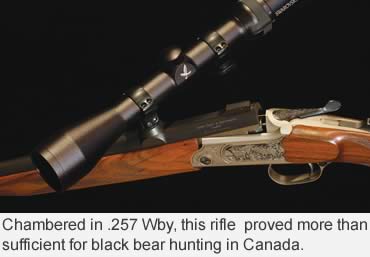 The Sharps became a hugely popular buffalo rifle. Scotsman Alexander Henry’s falling block was popular with European target shooters. John Browning’s first patent, the 1878 falling block, was later marketed as the Winchester Model 1885. It’s still available from a few manufacturers, including Browning and Winchester.
The Sharps became a hugely popular buffalo rifle. Scotsman Alexander Henry’s falling block was popular with European target shooters. John Browning’s first patent, the 1878 falling block, was later marketed as the Winchester Model 1885. It’s still available from a few manufacturers, including Browning and Winchester.
The Gibbs Farquharson was the first falling block using an internal striker. You recognize the type as the Ruger No. 1 and Dakota Model 10. Aficionados consider the Farquharson the epitome of rifle class, balance and elegance. Indeed, the sleek, trim lines of a Ruger, Dakota or the new top-end Soroka M07 look and feel like poetry in wood and steel. These falling-block designs are incredibly strong, too, capable of containing the pressure of any modern cartridge.
Advantages in Use
As suggested earlier, single shots don’t have numerous and obvious advantages over repeaters. Yet, there are some. As noted under the Bolt Action category above, the thick, steel bottoms of these actions make them more rigid than their open-bottom cousins, so they can, should and usually do enhance accuracy. That’s a definite advantage for target shooters, varminters and extreme-range shooters.
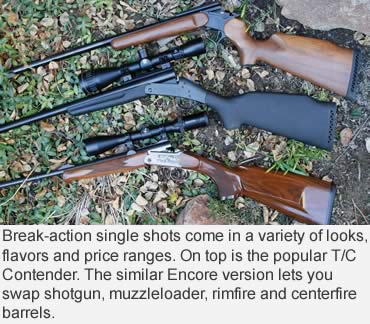 Another advantage for varmint shooters is that the single shot loading process slows down the action, potentially saving barrel life. Bullets ripping down already hot barrels and the sandblasting effect of unburned powder kernels increase bore erosion significantly.
Another advantage for varmint shooters is that the single shot loading process slows down the action, potentially saving barrel life. Bullets ripping down already hot barrels and the sandblasting effect of unburned powder kernels increase bore erosion significantly.
It’s all too easy to rapid fire with an AR or even a bolt action.
A bolt-action single shot can be loaded and fired faster than is wise for maximum barrel life. The process of reaching for a fresh round and dropping it onto the loading port forces a slight break in one’s concentration. With your eye off the dozens of scurrying targets downrange, you have a second to remember they aren’t going anywhere and your rifle might benefit from a more leisurely rate of fire.
The other single-shot advantage has also been mentioned: patience. Virtually everyone who’s ever hunted with a single disciplines himself to set up for a perfect shot rather than rushing things with the idea that three or five more rounds are a bolt-throw away.
As the old timers used to say: “One shot, meat. Two shots, maybe. Three shots, miss.” It’s not just a matter of rushing a shot or taking a low-percentage shot. With a single shot in hand, one’s hunting philosophy changes. You’re more cautious, more careful, more circumspect. This usually leads to patience and careful stalking leading to easy shots.
This doesn’t always mean close shots. Single shots are capable of extremely good accuracy. I’ve shot many that would group 1/2 MOA, and a couple that would cluster 1/4 MOA on a good day. Take your time and concentrate on making those long shots, and you’ll find these guns are more than adequate for the task.
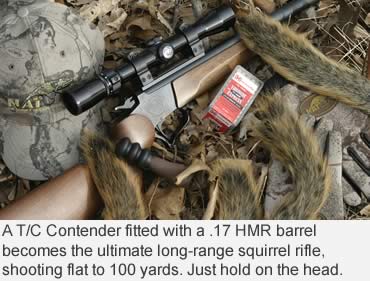 Not So Slow After All
Not So Slow After All
A common misconception about single-shot rifles is that users are relegated to just one shot at game. This is not true. Most single shots can be quickly reloaded. The trick is keeping cartridges accessible. You don’t want them buried in a pocket.
Some African PHs place a pair of fresh rounds between the fingers of their lead hand. They shoot break-action double barrels, but the loading sequence is the same. They can have a fresh round in the chamber in three seconds.
The same trick works for single shots, but you have to train to master it. Otherwise, it’s too easy to lose your grip on the cartridge during recoil or while making the transfer.
A better option for most hunters is a stiff leather cartridge wallet worn on the belt. Don’t push it far around the back. Keep it closer to your belly for easy access.
Some single-shooters prefer a wrist band that holds cartridges for quick access. Others tie or stretch a shellholder over the buttstock. Another option is a shellholder on the fore-end.
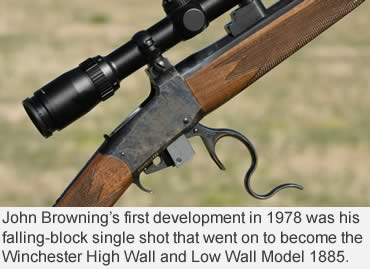 One other point about fast second shots: Many times, they aren’t needed. When game animals have no idea predators are in the area, they often don’t respond to one or two rifle shots. They might look around, jump a few feet and stop, but they don’t always flee. So you have plenty of time to reload and wait for a better second shooting opportunity.
One other point about fast second shots: Many times, they aren’t needed. When game animals have no idea predators are in the area, they often don’t respond to one or two rifle shots. They might look around, jump a few feet and stop, but they don’t always flee. So you have plenty of time to reload and wait for a better second shooting opportunity.
Modular Single Shots
Some single shots are remarkably versatile because the barrels can be easily swapped, and none more so than the Thompson/Center Encore rifle.
Thanks to its modular system, the Encore can be configured as not only a rifle with centerfire barrels from 204 Ruger through .416 Rigby, but also as a rimfire in .22 Long Rifle or 17 HMR. If that’s not enough versatility, add a shotgun or muzzleloader barrel. Change the stock from walnut to synthetic. Or change the rifle into a pistol.
Last year, Rossi introduced its new Wizard break-action single shot. Like the T/C Encore, it can be set up with a variety of rimfire, centerfire, shotgun and muzzleloader barrels. Centerfire barrels run from .223 Rem. through .30-06, plus .44 Mag, .45-70 and 7.63x39, the same low-cost ammo used by the AK-47. Rimfires are offered in .22 Long Rifle, .22 Magnum and .17 HMR. Shogun barrels come in .410, 20 and 12 gauge.
While the H&R Handi-Rifle can be swapped with a variety of centerfire rifle and shotgun barrels, each must be initially factory fitted. Barrels in .223 Rem through .30-06 and 500 S&W are available. Shotgun barrels come in .410 bore, 20 and 12 gauge. There are no muzzleloader barrels.
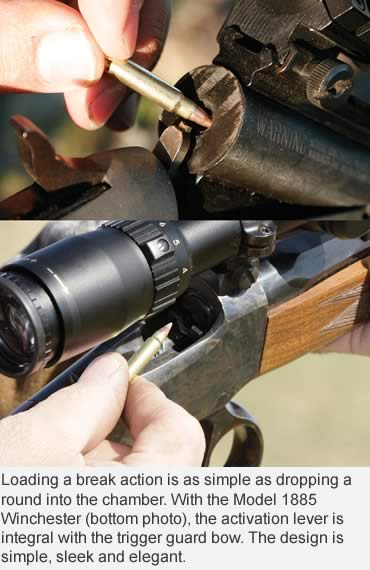 Glamour and Elegance
Glamour and Elegance
You can choose to believe that Farquharson falling-block action rifles are not the world’s classiest and most elegant, but you’ll be outvoted. More than a few experts have called this exquisite design “perfection of the rifle art.”
The lines are clean and smooth without superfluous curves, knobs or dangling participles. The actions are stronger than Fort Knox vaults and slicker than greased banana peels on hot butter.
These rifles are trim, wonderfully balanced and a delight to carry. They fly to the shoulder as if computer programmed, point as if crossed with an English setter and shoot so accurately you wonder why anyone would ever need more than one shot.
The original Farquharson was made only from about 1875 until 1910. Bill Ruger’s version, the No. 1, hit the streets in 1966 and has been going strong ever since.
Dakota upped the ante for elegance with its amazing Model 10 in the 1990s. Unlike every other Farquharson design, the Model 10 shows no external screws on its compact action.
Because Farquharson actions are so compact, barrels can be 26 to 28 inches without exceeding the overall length of most bolt actions with 24-inch barrels. The Miller falling block is famous for its target rifle accuracy, and the new Soroka promises to set a new level of high-end quality.
Old-School Romance
Sharps rifles are still being made to stellar quality by a number of small firms.
The Shiloh Sharps Rifle Manufacturing Co. of Big Timber, Mont., creates precision rifles in a variety of configurations and grades, and the workmanship is outstanding. They chamber numerous cartridges from .30-40 Krag to .50-70.
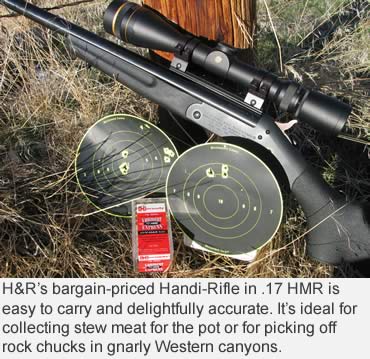 Cabela’s and Cimmaron F.A. Co. import Perdersoli-made Sharps rifles. Uberti markets at least six variations of Sharps, and Dakota builds a model scaled down to 80 percent of the original.
Cabela’s and Cimmaron F.A. Co. import Perdersoli-made Sharps rifles. Uberti markets at least six variations of Sharps, and Dakota builds a model scaled down to 80 percent of the original.
From time to time, Browning and Winchester produce limited runs of slick, accurate Model 1885 Low Wall and High Wall rifles, often chambered for modern high-pressure cartridges.
Uberti’s 1885 High Wall is chambered in .45-70, .45-90 and .45-120, just like the originals.
Other single shots are produced by manufacturers not listed here. Various used models show up on dealer shelves every day. A friend picked up an original trapdoor Springfield just last month.
The next time you’re in a shop, ask to examine their single shots. You might discover they’re just the shooting challenge and adventure you’ve been craving. And your shooting might improve, too.
Read Recent GunHunter Articles:
• Predator Calling Setup: Electronic callers make predator hunting easy. Here’s where to set up and what firepower to bring for success.
• Best Scopes for the Buck: Shop carefully, and you can find an inexpensive scope that hangs with you year in and year out.
This article was first printed in the August 2011 edition of Buckmasters GunHunter Magazine. Subscribe today to have GunHunter delivered to your home.